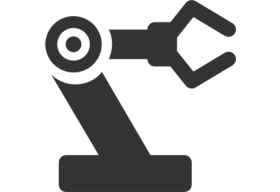This is an ambitious project that runs under linuxCNC. This machine is designed to "pick"
SMD components from some area on the table and "place" them onto your PCB. Its designed for prototype/low production work. Accuracy is < 0.002". It does NOT use tape reel feeds but instead you place strips or carriers on the table for a subsequent placement run. This projects is WAY too extensive to note here thus I'll be referring you to a build file.
The build file encompasses WIP (work in progress) and is a prototype build. For this reason ALWAYS read through an area before doing ANYTHING (I will return to some areas already written to warn you of this). However I'm NOT returning to any specific area for a complete re-write.
As mentioned this machine runs under linuxCNC regarding g-code runs and initial parallel port checks. The project begins with a build of a small footprint wooden base that is sized to 24" X 30". We've used openbuilds V rail system and most supporting parts. I do want to mention that sourcing is ALWAYS an issue with limited production tools that are not mass produced in some factory somewhere. For example we ordered the X axis motor driver, followed a couple of months later by the Y axis motor driver. Well the one we wanted to use for Y was the same one we used on X because it works great for our purposes.
Well, guess what? No longer available at previous price levels. Thus we purchased the "upgrade" (which of course is ALWAYS more expensive).
At this time (1.22.2014) I have not proofed the user build file that will detail this build from the ground up. I'm currently working on installing limit switches for the X axis (from openbuilds) and a IR LED for Home detection (physical switches are not fast enough).
This build entails a prototype parallel port controller that handles ALL aspects of movement locally. This means there is no Homing done by the host machine nor are any limits sent back to the host. ESTOP is handled locally as well. We use all 4 available parallel output lines (in addition to all 8 data bits) but we do not use ANY lines for input to the host.
Finally note that this is a "DR" machine. What I mean by that is that once a run begins its exact position is accomplished from a DEAD RECKONING (local machine home of all axis's) start. This means no cameras are used anywhere and no homing is done via the host. We use the Cartesian coordinate system but we do not any negative positioning numbers. Everything begins at X0/Y0/Z0/A0.
Vacuum AND pressure is used to control spring-loaded (expensive) nozzles. As noted this machine is FAST... capable on average of picking AND placing small components in < 2 seconds. Finally note that the A axis is used to rotate a component to any degree after pickup and before placement. And finally, finally, all Cartesian components are "blended" wherever possible. This means that all axis's move as a single entity (except Z and the vacuum/pressure nozzle control).
Note that when complete this will eventually be available as a kit for various stages. For one linux is used as the controlling host machine (PnP machines should NEVER be run under windows because a runaway due to a system crash could be hazardous!). Unfortunately many are not familiar with linux and therefore I'd be selling an option that uses a standalone linux host incorporated into the machine. You supply monitor, mouse, keyboard. I supply the Motherboard, video (probably onboard), parallel port, PSU, RAM, small hard drive, and some demo files to get you going. This will by no means be a state-of-art-system but will certainly be fast enough to get the dedicated job done.
Stay tuned for the initial file howto upload...
PnP 4 axis small/fast machine
Build in 'Everything Else' published by lewac, Jan 22, 2014.
You need some mechanical and electronic experience. This is NOT a novice undertaking! a familiarity with linux a plus (but not necessary). Basic woodworking and metal fabrication a big plus as well.
-
-
-
- Build Progress:
-
- Build in Progress...
Tiger74, notnek, Xiang Liu and 1 other person like this. -
-
Build Author lewac, Find all builds by lewac
-
- Loading...
-
Build Details
- Build License:
-
- CC - Attribution - CC BY
Reason for this Build
We needed a small/fast machine because we make things using SMD components. -
Parts list
Qty Part Name Part Link Comments 1 stay tuned Link many parts are referenced within the PnP user manual how-to. a detailed list will follow when complete. note that part sources change constantly.

